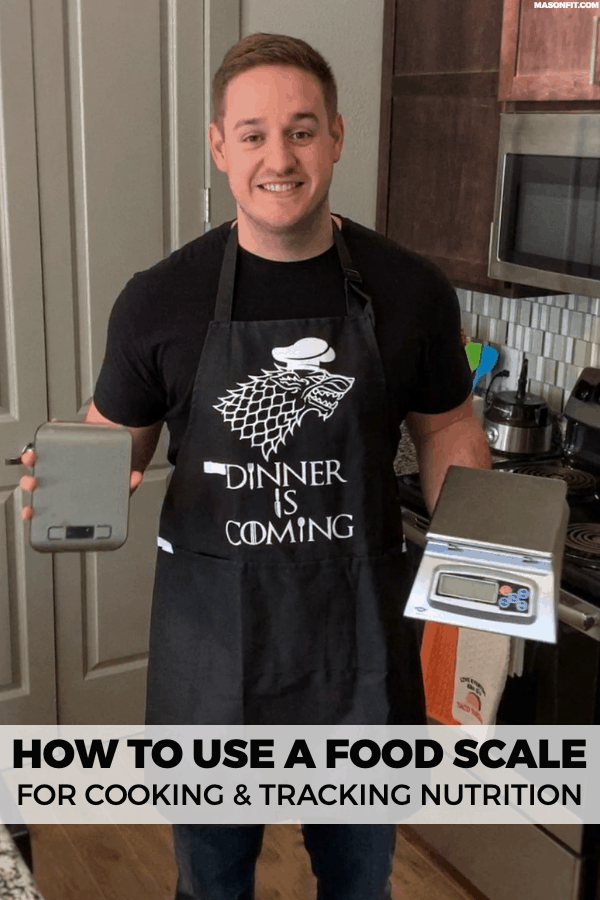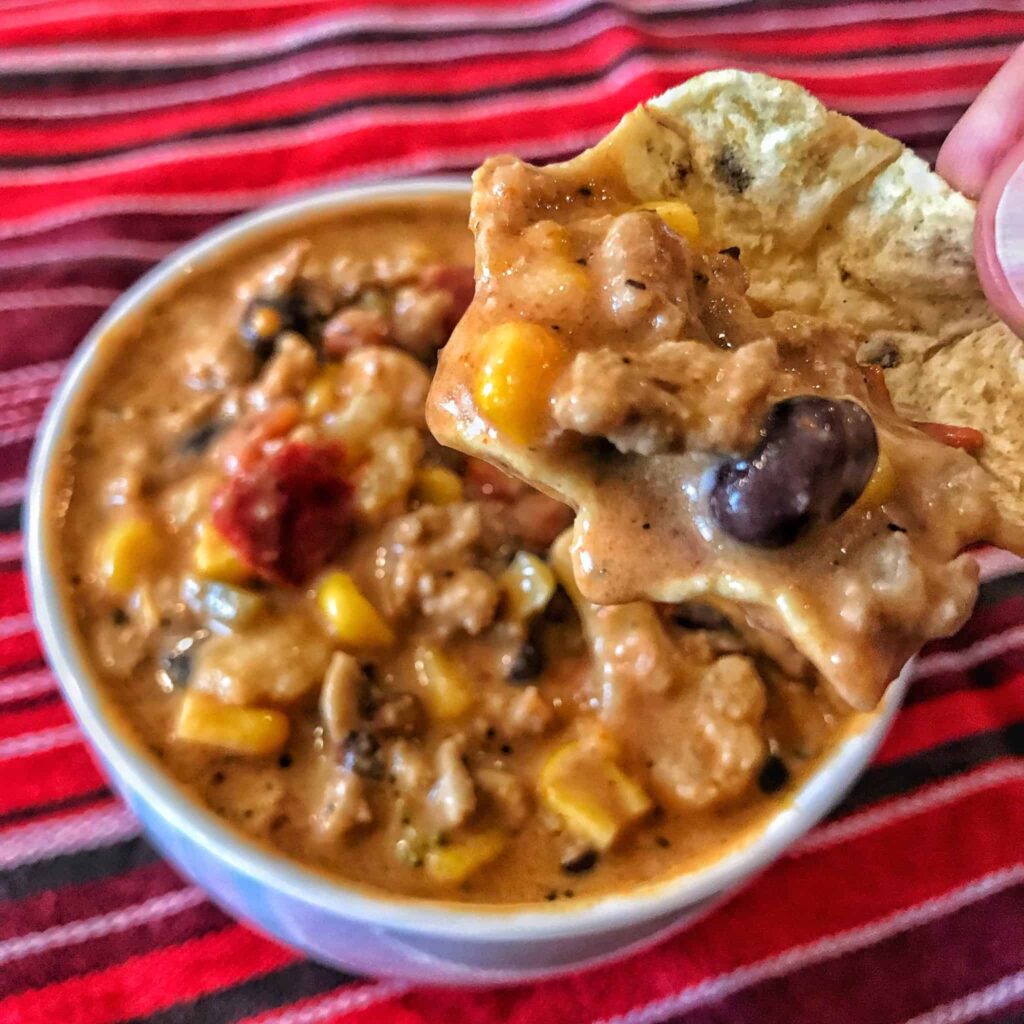Not a day goes by where I don’t use my food scale at least once. You may think it’s because I’m in the kitchen every day for work, but I used a scale almost daily before I started cooking for a living. It’s seriously one of the most underrated pieces of kitchen equipment you can buy.
In today’s article, I’m going to show you how to do three important things with a food scale:
- How to save time making recipes by weighing every ingredient.
- An easy way to add cooking oils, condiments, and sauces/dressings without adding an entire dish or pan to the food scale.
- How to calculate how many portions, the size of each portion, and the nutrition information for each portion of a bulk recipe like soup or chili.

Honestly, I racked my brain trying to come up with more things to teach you, but I couldn’t come up with anything beyond these three. Once you have these things down, you’re pretty much a food scale wizard in my book.
Using a Food Scale for Weighing Ingredients in a Recipe
If you’re still measuring ingredients without a food scale, I feel bad for you, son. I got 99 problems but washing 12 measuring spoons ain’t one.
A handful of reasons to weigh ingredients:
- You’ll have fewer dishes to wash, and it’s 10x faster without digging through your cabinets for the right measuring cup.
- You’ve likely heard that baking is a science. Being short a tablespoon of flour can make or break some recipes.
- If you’re tracking your intake, you might as well be accurate. Wanna doubt every protein shake you’ve ever consumed? Just weigh your next scoop of protein. I bet you’re way off from what the label reads.
- It’s faster. Like, a lot faster. Did I say that already?
Here’s how to do it:
- Place your mixing bowl on the food scale.
- Zero out the scale by using the “tare” button or corresponding function key. If the recipe you’re using calls for grams, be sure the scale is set to grams.
- Add your first ingredient to the mixing bowl.
- Zero out the food scale again.
- Add the second ingredient and repeat this process until you’ve added every ingredient.
How to Reverse Weigh Oils, Condiments, and Sauces
Let’s say you have a hot skillet that needs a bit of oil or a giant bowl of dressing-less salad that won’t fit on your food scale. Instead of dirtying another dish weighing your oils, condiments, or other toppings, simply weigh it in reverse. Here’s how to do it:
We’ll be using cooking oil for this example.
- Place the entire bottle of oil on the food scale.
- Zero out the scale.
- Remove the bottle and add the oil to the pan, slowly.
- Place the bottle back on the scale. The number on the scale will be negative and tell you how much oil is “missing” from the bottle. That’s how much you used.
This method works best for times you don’t need precision. If you need one teaspoon of oil, I wouldn’t recommend this method.

On the other hand, if you need Greek yogurt to use a garnish for southwest quesadillas and haven’t pre-planned how much you’re going to use, it’s perfect. Simply zero out the scale with the yogurt on it, plop a big spoonful in a bowl, and go about your day.
How to Calculate Portions and Macronutrients per Portion in Bulk Recipes with a Food Scale
So you just made a giant pot of my high protein creamy taco soup OR shredded BBQ chicken with a modification, and you need to know the adjusted macros. How do you do it?
- Place a large container on the food scale and zero out the scale.
- Transfer the recipe in its entirety to the large container. Note the recipe’s total weight. (For this example, let’s say the recipe weighs 2,000 grams.)
- Add all the ingredients to a tool like MyFitnessPal to calculate the recipe’s total macros and calories.
- Divide the total macros and calories by however many servings you’d like. If a recipe has 3,000 total calories, you could have six 500-calorie servings, ten 300-calorie servings, or any number of servings you need to fit your diet.
- The weight of your servings will depend on how many servings you want in step 4. Let’s say you want to go with the six 500-calorie servings. You would simply divide the 2,000 grams by six and there you have it—each serving would weigh 333 grams.
- You can either divide the recipe into portions right away by transferring 333 grams into six containers or write a note on the large container and weigh each portion before reheating.

I forgot to mention this in the video but if you weigh the pot or dish you’re cooking with beforehand (or you know from previous recipes), you can weigh the entire pot without transferring to a large container. It might help to place a pot holder or cloth on top of the food scale so you don’t have to wait for the pot to completely cool.
The Weight is Over
All right, I think that should do it. Don’t hesitate to leave a comment on this post if you have any questions. Go forth and conquer!
P.S. I’m an investor in a new macro balanced foods company called Counter. They have an awesome, completely free macro calculator you should check out.
P.S.S. If you’re new to macro counting and need some recipe inspiration, check out my round up of 40 macro friendly meals.

Annie
Thursday 18th of November 2021
So, after dividing the macros and cals by your desired servings, you get your cal/serving and your weight/serving. But, how do you determine the grams of carb/fat/protein specifically for each of those servings? Would love to hear back for some tips!
Mason Woodruff
Tuesday 23rd of November 2021
I enter everything into a calculator like MyFitnessPal and divide the macronutrients by the number of servings.
Mason
Monday 14th of September 2020
Fellow Mason, hello! So I was curious if cooking the food reduces the weight and if so, how to account for this?
Mason Woodruff
Tuesday 15th of September 2020
Two Masons don't make a right. The weight of foods will definitely change from raw to cooked. Most meats have a 20-30% shrink rate, for example. That means one pound of raw meat may weigh 12 ounces after cooking. The nutrition facts don't change between the one pound of raw meat and 12 ounces of cooked meat, however. I always like to say raw ingredient weight is for recipe accuracy and cooked weight is for serving size and nutrition facts. Hope that answers your question!
Samantha D
Wednesday 9th of January 2019
Sooooooo, weigh the jar of oil, jelly, syrup or anything liquid first then weight again, genius. Why have I never done this? That alone has saved me multiple spatulas! Great article, great tips! Keep em coming!
Hillary Shemin
Wednesday 12th of September 2018
Great article! Thanks so much. I’m a WW Lifetimer (from many years ago) I gained, lost, gained and lost, etc, but back to goal. I’vee been struggling and have just started using My Fitness Pal to compliment my WW App. I love your recipes, but have been unsure hiw to figure out my recipes that might be “Zero Heroes”, but full if lots of calories and a mix of macros. Your information here will really help. I saved it as it is going to be a challenge once I do make a big pot of something! Thanks so much!!!
Mason Woodruff
Thursday 13th of September 2018
Thanks so much for the feedback, Hillary! I understand the uncertainty. A common request on my site is for Smart Point calculations, but I've found it to be a bit difficult to convert unless I use the WW calculator exclusively. Anyway, feel free to send me an email or message if you ever need any help with anything. Digging into the macros of foods is more work, but it truly gives you a bigger picture and more control over your diet/intake. Good luck!